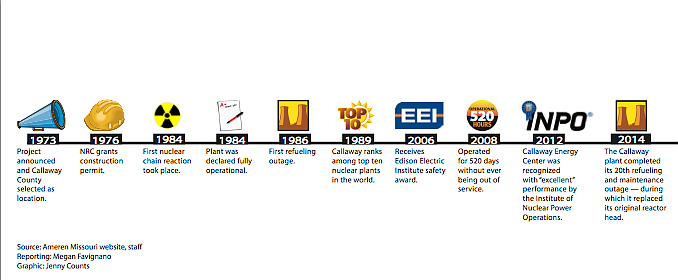Thirty years ago today, Dec. 19, the Callaway Energy Center was declared fully operational and started contributing power to Ameren Missouri's grid. The nuclear facility now generates about 20 percent of Ameren Missouri's electricity for its 1.2 million customers.
The United States Nuclear Regulatory Commission (NRC) granted the plant a 40-year operating license in 1984. With that operating license set to expire in 2024, Callaway Energy center has filed for a license renewal with the NRC. If granted, the plant license would be extended to 2044.
John Patterson, director of nuclear projects at the Callaway Energy Center, has worked with the plant for 34 years. When Patterson first came to the nuclear facility in 1980, the plant was still in construction - the nuclear facility received its construction permit from the NRC in 1976.
Ameren Missouri selected Callaway County and announced the project in July 1973.
In his more than 30 years working for the plant, Patterson has worked with the maintenance team and was previously a shift manager and outage manager.
"Callaway plant employees are members of the community. We live and work in the community," Patterson said. "We take that pride in working with our community to instill our values and there's an understanding that this is not a game to us. We take this very seriously."
Patterson told the Fulton Sun major milestones he has seen in his 34 years at the plant:
Refueling and maintenance outages
The nuclear facility has planned outages every 18 months, during which it changes fuel in the reactor and performs maintenance tasks. The plant's 20th and most recent outage was this past fall.
Ameren Missouri considers this last planned outage one of the largest in the Callaway Energy Center's history. The plant replaced the original reactor vessel head that was installed when the nuclear facility went online in 1984. That new reactor vessel head was a $150 million piece of equipment.
"It allowed the plant to be more reliable and provide us a better margin for continued operation," Patterson said.
The plant replaced steam generators, a multi-million dollar project, during a refuel and maintenance outage in 2005, Patterson said.
"This is all part of bettering the plant and allowing us to operate for our 40-year license, plus," Patterson said. "This increased our equipment reliability by changing the steam generators."
Breaker-to-breaker runs
Since 2008, the nuclear plant has had two breaker-to-breaker runs - the nuclear facility did not have any unplanned outages between its planned outages that occur every 18 months.
"We went from refuel to refuel with continuous operations," Patterson said. "Those are pretty big milestones."
The Callaway plant remained consistently online or in service for 520 days in fall of 2008. Its second breaker-to-breaker run was in 2011. At that time, the plant was online for all 489 days between planned outages.
INPO recognition
In 2012, the Institute of Nuclear Power Operations (INPO) recognized the Callaway Energy Center for excellent performance. INPO gave the nuclear plant its highest rating for plant operations and reliability. Patterson described INPO as a nuclear industry watchdog group. He said obtaining such a high recognition with them took a lot of hard work and effort from all of the plant's employees.
"That was a plant accomplishment where everybody worked together to get that rating," Patterson said.
To get that rating recognition, Patterson said the plant took some actions that sound simple but made a big difference. One of those initiatives was working on procedure adherence. The plant worked to reinforce procedures with employees and ensured that employees understood how procedures contributed to the plant's operations.
"We spent a lot of effort to increase the skills and knowledge level of our folks so they had a better understanding of how the plant ran and worked. By doing that, we were able to work together more as a team and come together to solve issues," Patterson said. "And at the same time increase the excellence of our operating department - where we were able to handle minor events at the plant and not have them cascade and keep the unit online."
Patterson said the INPO rating is one of the milestones of which he is most proud.
"That put us into a grade of excellence among our peers," Patterson said. "People come to us looking for that guidance and what did we do to obtain that rating."
Fukushima response
The plant, Patterson said, has been working on changes in response to NRC Fukushima orders. After the 9.0-magnitude earthquake and 45-foot tsunami struck Japan in spring 2011, Japan's Fukushima Dai-ichi nuclear facility had significant damage. The NRC, because of that event, took action on its own policies in an effort to make U.S. nuclear facilities better prepared for disaster.
The Callaway plant did some maintenance during its most recent planned outage to follow NRC's Fukushima orders.
"Making sure we (the nuclear plant) are covered in all seismic and tornado (events) - hardening the plant for natural disasters," Patterson said. "That's another big project we are working through right now."

